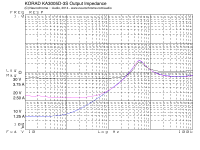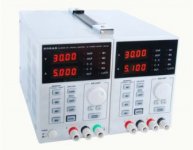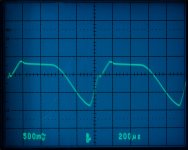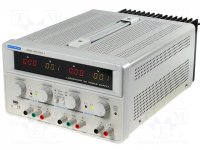Does anyone have first-hand experience with the Korad power supplies, such as the KA3005D-3S?
The supplies are rather inexpensive. For example, the 2x 0~30 V @ 0~5 A; 1x 5.0 V output version is only about $180. It features digital adjustment of the output voltage/current via a front panel knob, four memories, and USB connection.
EEVBlog has a tear-down review video of the single output version. I believe the single output is $120... You certainly get your money's worth it seems like. Granted, the build quality could be better, the boards could be washed, etc. but for $120... Not bad.
Has anyone here tried any of these supplies? I'm curious about what the output impedance is and how much residual ripple is on the output.
~Tom
The supplies are rather inexpensive. For example, the 2x 0~30 V @ 0~5 A; 1x 5.0 V output version is only about $180. It features digital adjustment of the output voltage/current via a front panel knob, four memories, and USB connection.
EEVBlog has a tear-down review video of the single output version. I believe the single output is $120... You certainly get your money's worth it seems like. Granted, the build quality could be better, the boards could be washed, etc. but for $120... Not bad.
Has anyone here tried any of these supplies? I'm curious about what the output impedance is and how much residual ripple is on the output.
~Tom
I decided to answer my own question. I purchased an KA3005D-3S from SRA Soldering Products.
The KA3005D-3S is pretty obviously two KA3005Ds in one chassis. Fair enough. In addition, with the dual supply, you get an unmarked +5 V, 3 A supply as well.
If you have read any of the online reviews, you will know that the manual is a joke and that the fan is loud. I agree with those.
The fan measures about 50 dB(A) at idle and increases to about 60 dB(A) at full speed. These numbers measured about 30-40 cm from the supply using an SPL meter app from Studio Six Digital. This is loud enough to make me go, "ah...." when I turn the supply off. One could easily swap the fans out for some low-noise types, though. Of course, then you're adding $40 worth of fans to a $170 supply...
The manual is in Chinglish and is absolutely useless. Then, on the other hand, it's a power supply... It's not rocket science.
The supply section on the left, I'm sure, is an unmodified KA3005D single supply. The supply section on the right has the +5 V output added and has some of the buttons repurposed for additional functions: Series (SER) and parallel (PARA) modes. Hold in the SER button for a second or so, the supply goes beep, and the SER LED lights up. Then connect the load (+) to the red terminal on the left supply section and the load (-) to the black terminal on the right supply section. Dial in the voltage on the right supply section, but note that you get twice the voltage indicated on the display. Similarly, the PARA mode allows you to connect the two supply sections in parallel. Connect the load to the terminals on the right supply section and dial in the voltage and current there. Note that you get twice the indicated current. These features are a little clunky, but if you keep in mind that you're dealing with two supplies in one box, it sorta makes sense.
The beep sound is rather anemic. Not a big deal and you can turn it off ... but only on the left supply section as the BEEP OFF button has been repurposed on the right supply section. That's truly one of those, "really?!" kinds of moments.
User interface and fan noise issues aside, the supply is pretty damn solid. I ran it at 2x 24 V, 5 A for an hour and it never complained.
The indicated voltages and currents are not super precise, but probably within ±1 % of the actual value (for a DC load anyway). That's certainly good enough.
The ripple voltage was low enough that I didn't bother to write it down. The specs say <1 mV RMS, which was definitely the case on my unit.
The output impedance is nice and low. It varies with the load current, as you'd expect, and shows good stability of the control loop (no high-Q peaking). Except for a hump at 5 kHz, the output impedance is below 10 mΩ for all the voltage/current combinations I tested (see attached plot).
An interesting quirk is that the ammeters in the supply are not RMS ammeters. It appears the current is sampled by the same micro controller that handles the user interface, so when presented with a pulsed load (such as a Class AB output stage), the ammeter will show currents anywhere from close to zero to somewhere around the peak value, depending on where in the cycle the current was sampled. This is a bit disappointing, but given the low cost of the unit, I can't complain too loudly.
The bottom line is that for $200 shipped, you get a lot of bang for your buck. To get something that's significantly better, you'd be looking at getting two HP/Agilent/Keysight E3632A supplies at $1200 each.
I did look at building my own supplies. I have the transformers for it and can probably dust up some output devices as well. Even so, I would be hard pressed to build a supply as good as the Korad for less than $200.
~Tom
The KA3005D-3S is pretty obviously two KA3005Ds in one chassis. Fair enough. In addition, with the dual supply, you get an unmarked +5 V, 3 A supply as well.
If you have read any of the online reviews, you will know that the manual is a joke and that the fan is loud. I agree with those.
The fan measures about 50 dB(A) at idle and increases to about 60 dB(A) at full speed. These numbers measured about 30-40 cm from the supply using an SPL meter app from Studio Six Digital. This is loud enough to make me go, "ah...." when I turn the supply off. One could easily swap the fans out for some low-noise types, though. Of course, then you're adding $40 worth of fans to a $170 supply...
The manual is in Chinglish and is absolutely useless. Then, on the other hand, it's a power supply... It's not rocket science.
The supply section on the left, I'm sure, is an unmodified KA3005D single supply. The supply section on the right has the +5 V output added and has some of the buttons repurposed for additional functions: Series (SER) and parallel (PARA) modes. Hold in the SER button for a second or so, the supply goes beep, and the SER LED lights up. Then connect the load (+) to the red terminal on the left supply section and the load (-) to the black terminal on the right supply section. Dial in the voltage on the right supply section, but note that you get twice the voltage indicated on the display. Similarly, the PARA mode allows you to connect the two supply sections in parallel. Connect the load to the terminals on the right supply section and dial in the voltage and current there. Note that you get twice the indicated current. These features are a little clunky, but if you keep in mind that you're dealing with two supplies in one box, it sorta makes sense.
The beep sound is rather anemic. Not a big deal and you can turn it off ... but only on the left supply section as the BEEP OFF button has been repurposed on the right supply section. That's truly one of those, "really?!" kinds of moments.
User interface and fan noise issues aside, the supply is pretty damn solid. I ran it at 2x 24 V, 5 A for an hour and it never complained.
The indicated voltages and currents are not super precise, but probably within ±1 % of the actual value (for a DC load anyway). That's certainly good enough.
The ripple voltage was low enough that I didn't bother to write it down. The specs say <1 mV RMS, which was definitely the case on my unit.
The output impedance is nice and low. It varies with the load current, as you'd expect, and shows good stability of the control loop (no high-Q peaking). Except for a hump at 5 kHz, the output impedance is below 10 mΩ for all the voltage/current combinations I tested (see attached plot).
An interesting quirk is that the ammeters in the supply are not RMS ammeters. It appears the current is sampled by the same micro controller that handles the user interface, so when presented with a pulsed load (such as a Class AB output stage), the ammeter will show currents anywhere from close to zero to somewhere around the peak value, depending on where in the cycle the current was sampled. This is a bit disappointing, but given the low cost of the unit, I can't complain too loudly.
The bottom line is that for $200 shipped, you get a lot of bang for your buck. To get something that's significantly better, you'd be looking at getting two HP/Agilent/Keysight E3632A supplies at $1200 each.
I did look at building my own supplies. I have the transformers for it and can probably dust up some output devices as well. Even so, I would be hard pressed to build a supply as good as the Korad for less than $200.
~Tom
Attachments
Last edited:
Hmmm... Apparently, small-signal output impedance is one thing; large-signal output impedance quite another. Attached is a scope shot of the supply ripple when the Korad is loaded by a class AB output stage providing 1 kHz @ 40 W into a 4 Ω load (4.47 A peak; 1.58 A RMS). Pretty pathetic...
I think this one goes back to SRA...
~Tom
I think this one goes back to SRA...
~Tom
Attachments
I was surprised too. I'm guessing the micro controller used for the display handles the voltage regulation as well and flat out runs out of bandwidth. The output voltage actually increases by about 0.5 V under these load conditions. I put a 1000 uF cap across each output, that helped some. Above scope shot was done with the 1000 uF in place.
I guess I'll be building my own supply. It's not hard. It's just time consuming.
~Tom
I guess I'll be building my own supply. It's not hard. It's just time consuming.
~Tom
My guess from the waveform is that the Korad has a slew rate limitation in the control loop. The downward slope may be the control loop failing to turn the pass transistor/MOSFET on fast enough as the class AB output stage current increases. Then the output stage current falls and the ouput recovers.
My guess is that they have used a power stage with gain such as a PNP transistor or P channel MOSFET to keep the drop out voltage to a minimum. Then used high value capacitors (but low current control circuit) to keep the voltage regulation loop stable.
My guess is that they have used a power stage with gain such as a PNP transistor or P channel MOSFET to keep the drop out voltage to a minimum. Then used high value capacitors (but low current control circuit) to keep the voltage regulation loop stable.
Hi,
I was thinking in buying a PSU for testing power amplifiers but your post gave me second thoughts... is it expected to find similar behavour from all cheap PSUs? I was thinking in buying this one: MPS-3003L-3 MATRIX - Pwr sup.unit: laboratory | TME - Componentes eletrónicos
What are your thoughts about this PSU?
Thanks
I was thinking in buying a PSU for testing power amplifiers but your post gave me second thoughts... is it expected to find similar behavour from all cheap PSUs? I was thinking in buying this one: MPS-3003L-3 MATRIX - Pwr sup.unit: laboratory | TME - Componentes eletrónicos
What are your thoughts about this PSU?
Thanks
Most of the ones with 3003 or 3005 in the name are just rebadges of the Korad power supplies.Hi,
I was thinking in buying a PSU for testing power amplifiers but your post gave me second thoughts... is it expected to find similar behavour from all cheap PSUs? I was thinking in buying this one: MPS-3003L-3 MATRIX - Pwr sup.unit: laboratory | TME - Componentes eletrónicos
What are your thoughts about this PSU?
Thanks
Most of the ones with 3003 or 3005 in the name are just rebadges of the Korad power supplies.
But it looks very different. It's still the same PSU?
Attachments
But it looks very different. It's still the same PSU?
Anybody has experience with this PSU? It's rebadged in other brand names but doesn't seem to be a korad. Will it behave poorly like the korad? Sould I risk buying it?
http://www.tme.eu/pt/details/mps-3003l-3/fontes-de-alimentacao-multicanal/matrix/#
Thanks.
Last edited:
It looks near as makes no difference identical to this one from GW Instek (but then with 4 instead of 2 displays):

We have several of these at work, and they are 15+ years old and still going strong. No problems.
Some of them actually are rebranded as Tektronix, so should be good enough to be sold under that well-known brand...

We have several of these at work, and they are 15+ years old and still going strong. No problems.
Some of them actually are rebranded as Tektronix, so should be good enough to be sold under that well-known brand...
Last edited:
It looks near as makes no difference identical to this one from GW Instek (but then with 4 instead of 2 displays):

We have several of these at work, and they are 15+ years old and still going strong. No problems.
Some of them actually are rebranded as Tektronix, so should be good enough to be sold under that well-known brand...
That exterior is found with a variety of internals, so its quite possible they purchased the guts for a Korad supply and used those externals. It's also equally as likely that they just copied the model number style and there is no relation at all. The single channel version of this exterior is even more copied and the internals vary heavily in quality. It's not at all an uncommon practice in cheap power supplies. Get the guys from one discount firm, the shell from another. Whoever gives the cheapest price. I can promise that this supply is not rebadged as a Tek.
Last edited:
That exterior is found with a variety of internals, so its quite possible they purchased the guts for a Korad supply and used those externals. The single channel version is even more copied. It's not at all an uncommon practice in cheap power supplies. Get the guys from one discount firm, the shell from another. Whoever gives the cheapest price.
Of course I can't be sure that the internals of the Matrix (hmmm, that somehow sounds familiar) PSU are the same as the GW Insteks and Tektronixs we have at work.
I can promise that this supply is not rebadged as a Tek.
Maybe not the Matrix, but certainly the GW Instek from my previous post, we have several of these:

To me these look like GW Insteks with a Tek badge... And why not? The quality of them is fine.
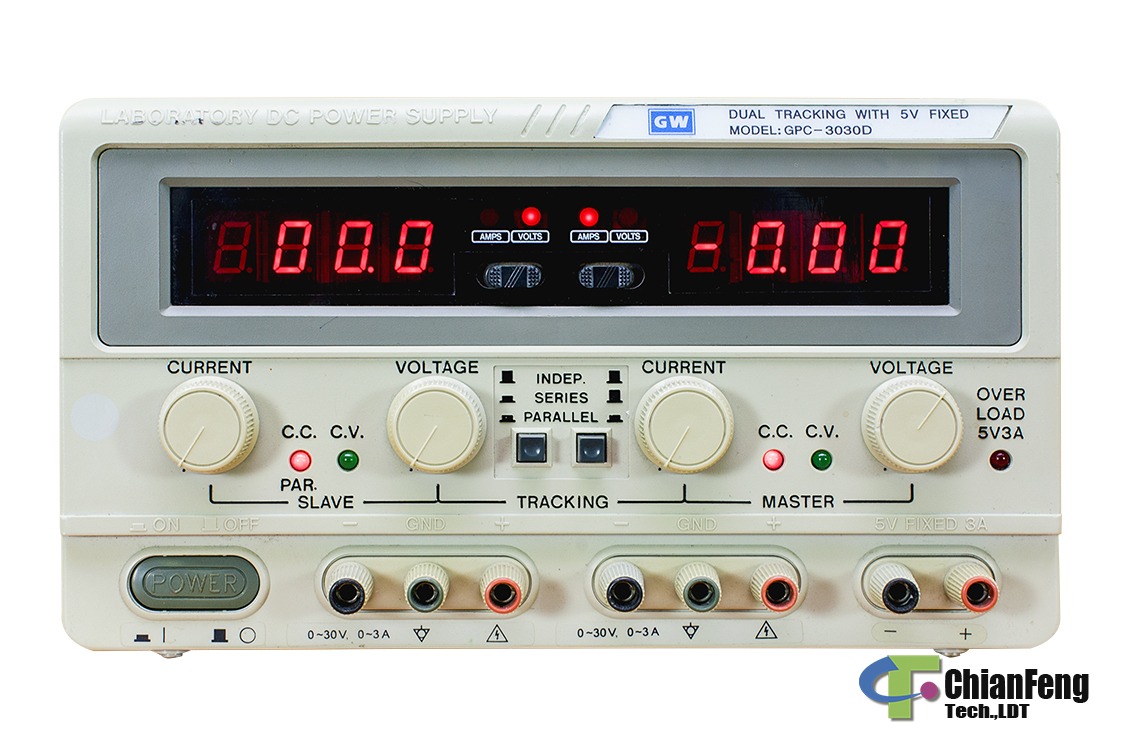
Last edited:
I delved a bit deeper and found some tear down pictures on a Polish website of a smaller Matrix PSU (MPS-3005S).
If the dual MPS-3003L-3 is anything alike, then I can tell you that the internals of the Matrix are definitely different from the GW Instek/Tek models from my previous post. They may have it made to look like it (esp. the pattern of the ventilation holes in the cover had me fooled), but it certainly isn't.
Next week I'll have a look inside the GW Insteks and Teks at work, and maybe take a few pics for comparison. But remember, these are 15+ years old.
Did you also see the other video by EEVblog on the KA3005P? Not only does this PSU show some strange behaviour when the output is switched on while it is loaded, he also manages to unintentionally blow it up with the electronic load. Then there's the follow up video with a revised version to remedy the susceptibility to being blown up.
If the dual MPS-3003L-3 is anything alike, then I can tell you that the internals of the Matrix are definitely different from the GW Instek/Tek models from my previous post. They may have it made to look like it (esp. the pattern of the ventilation holes in the cover had me fooled), but it certainly isn't.
Next week I'll have a look inside the GW Insteks and Teks at work, and maybe take a few pics for comparison. But remember, these are 15+ years old.
EEVBlog has a tear-down review video of the single output version. I believe the single output is $120... You certainly get your money's worth it seems like. Granted, the build quality could be better, the boards could be washed, etc. but for $120... Not bad.
Did you also see the other video by EEVblog on the KA3005P? Not only does this PSU show some strange behaviour when the output is switched on while it is loaded, he also manages to unintentionally blow it up with the electronic load. Then there's the follow up video with a revised version to remedy the susceptibility to being blown up.
comparing Tek and GW PSUs
As promised a follow up on the Tektronix and GW PSUs.
Yesterday I took the cover off a Tektronix PS280, a GW GPC-3030DQ and a GPC-3030.
Note that the Tek has different specs: 2x 0-30 V/0-2A whereas the GWs are 2x 0-30 V/0-3A (all also have a fixed 5 V/3 A output).
Unfortunately, there's no direct comparison possible. Contrary to what I thought, we don't have models that are identical (apart from the badge). Also, the Teks seem to be a couple of years older. Having said that, to me there's no doubt the Teks come from the same factory. The numbers used for identifying the pcbs in the Tek are the same as in the GW (all starting with "GPC") and the same brands of components are used. PSUs are all made in Taiwan, BTW.
The Tek does have quite a different layout, splitting funcionality between several boards while the GW does everyting on one board (except fixed 5 V output). The Tek has (mostly) passive cooling whereas the GW relies on a (non-temperature controlled) fan.
Here are a few pics.
Tek left side. Tek right side. GW left side. GW right side (left side from '3030DQ model, right side from '3030 model which has analogue displays, but internals are otherwise identical to the '3030DQ).
As promised a follow up on the Tektronix and GW PSUs.
Yesterday I took the cover off a Tektronix PS280, a GW GPC-3030DQ and a GPC-3030.
Note that the Tek has different specs: 2x 0-30 V/0-2A whereas the GWs are 2x 0-30 V/0-3A (all also have a fixed 5 V/3 A output).
Unfortunately, there's no direct comparison possible. Contrary to what I thought, we don't have models that are identical (apart from the badge). Also, the Teks seem to be a couple of years older. Having said that, to me there's no doubt the Teks come from the same factory. The numbers used for identifying the pcbs in the Tek are the same as in the GW (all starting with "GPC") and the same brands of components are used. PSUs are all made in Taiwan, BTW.
The Tek does have quite a different layout, splitting funcionality between several boards while the GW does everyting on one board (except fixed 5 V output). The Tek has (mostly) passive cooling whereas the GW relies on a (non-temperature controlled) fan.
Here are a few pics.
Tek left side. Tek right side. GW left side. GW right side (left side from '3030DQ model, right side from '3030 model which has analogue displays, but internals are otherwise identical to the '3030DQ).
Last edited:
Maybe not the Matrix, but certainly the GW Instek from my previous post, we have several of these.............To me these look like GW Insteks with a Tek badge... And why not? The quality of them is fine.
I need to see the rear tag so to be convinced if this is a true GW Instek PSU.
The rear tag of which supply do you need to see? I can only show those of the GW and Tek, but not of te Matrix.
But I'm already convinced that the Matrix is completely different, a couple of steps down the ladder when it comes to build quality. Can't say anyhting about the functionality or longevety of the Matrix. The GW and Teks have seen quite a few operational hours (low power) and are all working fine after 15 or more years...
But I'm already convinced that the Matrix is completely different, a couple of steps down the ladder when it comes to build quality. Can't say anyhting about the functionality or longevety of the Matrix. The GW and Teks have seen quite a few operational hours (low power) and are all working fine after 15 or more years...
- Status
- This old topic is closed. If you want to reopen this topic, contact a moderator using the "Report Post" button.
- Home
- Design & Build
- Equipment & Tools
- Korad power supplies
